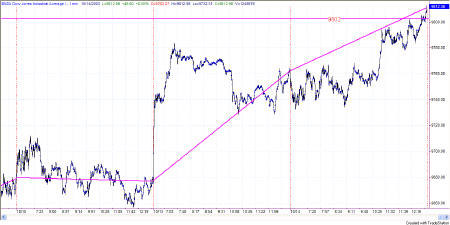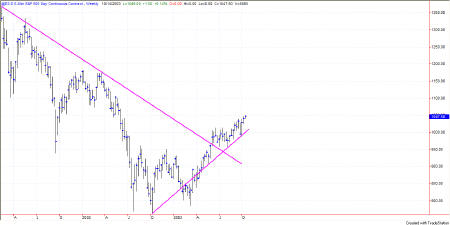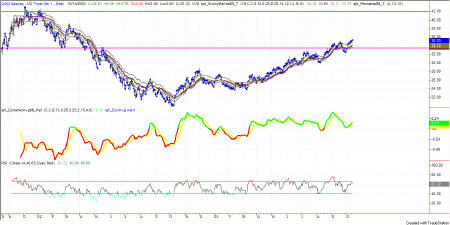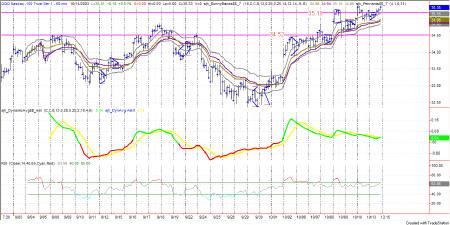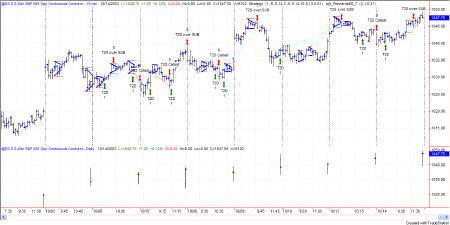
The Sunny Side of the Street
TECHNICAL ANALYSIS EDUCATION: EXPLAINED AND DECIPHERED FOR NEW AND
VETERAN TECHNICAL ANALYSTS ALIKE.
TUESDAY EVENING -
Oct 14, 2003
Archives of Past
Commentaries . How Did We Do?
Weekend Stock Picks --
CLICK HERE
| Anyone interested in posting comments or questions to the bulletin board may click here. Sunny personally answers each question or comment posted. | ||
I am conducting two seminars in January, if enough interest is shown. The seminars are intense workshops in which we not only follow a strict and intense agenda, but in which we take your specific questions and problems and work them into the content of the workshop. I will cover in depth the specific techniques I use that have been successful over the years, and show the ones which are not. I've been through the mill over the last 22 years, why should YOU have to reinvent the wheel? Interested? You send me your issues well in advance of the seminar and I tailor the discussions to address your issues. Only 15 people are allowed to come, and you'll be pleasantly surprised how much we cover in-depth. Click Here to view the agendas of the seminars. |
|
|
$56,893 in Stock Picks to date! Click Here to view.
While today's trendline (the magenta line I have drawn from yesterday's close to today's close) is of approximately the same slope, the days themselves were of very different character.
You can see for yourself on the chart in Figure 1a that yesterday's up move was largely based on the opening range gap, while today's move was a nice, sort of steady move up. The trade for the day was just to hold long from open to close. The trade, as called out by my system, bought on the bar after the open and sold to capture profits at 12:00pmPT (at 35.19 on the QQQ; 1045.25 on the ES). The rationale behind this trade was to buy in as price entered the Sunny_Bands and sell for profit when price dropped back to the midline from above.
On the weekly chart of the ES, ignoring such wonderful indicators as available to the modern technician, the trendlines show us that we have broken the long-term downtrend and are now in a bull market. A bull market is characterized by a move up of 20% or better. This move, since the bottom in 10/2002, has moved from 762 to its current 1047, which is a move of just over 37%. It qualifies.
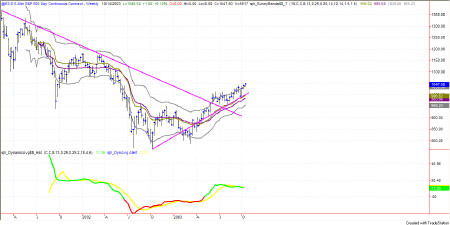
Figure 1c: Weekly ES with modern indicators
The same chart with modern day indicators shows us that weekly prices are over the top of the Sunny_Bands, and thus bullish. Therefore, from both aspects, vote 1 is bullish.
On the daily chart, the QQQ is well above the upper band, the SDMAhist is bullish and the RSI is still hanging in there at high levels. Vote 2 is bullish.
On the 60 minute chart, price yesterday stayed above the pennant top formed on the 9th, and by midmorning today a new pennant had formed whose top lies at 35.18. The market past the pennant continued to breakout and stay above the pennant line; a very positive note. Now we are showing tops forming with nothing in the near past to use as a guideline for higher breakouts. Another very bullish sign. Vote 3 is bullish.
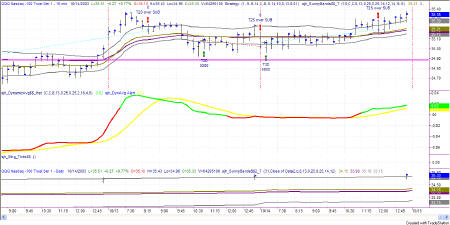
Figure 1e: QQQ 15 minute trading chart.
As I said earlier, my trading strategy got me long and kept me long for most of the day. A good position to be in.
The SDMA_Hst is now in a more bullish position, with green above yellow, and red has turned to green. That just says that the SDMA lines have crossed in a bullish direction and that we seem to be coming off of the sideways positioning we have been in for several days. It wouldn't surprise me now to see a strong move upward to cut through the tops and breakout into new territory.
In Figure 1f you can see how the EMini chart matches up to the entries & exits on the QQQ chart. The entry on this morning's Sunny_Bands signal was delayed by one bar from the QQQ entry, but the profit taking exit was proportionately delayed, and probably took just a bit more profit. In both cases it was a very nice trade.
The long-range chart of the QQQs shows that we have surpassed the most recent line of resistance, which is now support, and could be in for higher, and higher highs. One alternate scenario, of course, is for the support to be tested with a drop and a bounce. (See Figure 1g) The magenta line at the top of the chart is drawn at the next level of tops in the past, which gives us a goal for the future. That line levels out at 42.00. It's hard to tell whether this 3-wave we are currently in will accelerate the curve and run right on up to 42, or whether it will run up a little farther and then make the 4-wave turn back to support. In any case, it looks like we are going for the 42 mark in the not so distant future.

Figure 1g: Daily QQQ with support & resistance
Attractor: a level to which prices seem to be drawn, like a magnet. Usually these are lines of support or resistance from previous highs and lows, but can also be an important level on an indicator, or the edge of a Sunny_Band.
PHW: Potential Hourly Wage. A term coined by Sunny to examine whether trading for a living is really worth it when compared to the minimum wage standard. Before considering a trading system to be a success, it should pass the PHW test.
RSI: Relative Strength Index (TradeStation function)
SDMA: Sunny's Dynamic Moving Average (proprietary)
SDMA_Hst: Sunny's Dynamic Moving Average presented in a histogram format where the line representing the difference between the two SDMA lines turns from red to green when the two SDMA lines cross each other (the difference is zero). The yellow line is an average of the histogram line.
Sunny_Band: Sunny's Dynamic Moving Average plus 1.5 ATR and minus 1.5 ATR, creating a band on either side of the SDMA.
This commentary is meant only for EDUCATIONAL PURPOSES. It is to help you see how a Technical Analyst reads the signs in the markets.
Stay sharp and on your toes. Moves can reverse on a dime, anytime. Let the market speak to you. If the market is going down, by golly ignore my commentary from the night before and know that the market is going down.
RULES OF THUMB:
0. I keep the chart in Figure 1a on each day's commentary simply to illustrate how much in tandem the 4 indexes I watch actually are. For this reason, I don't always comment on every index. Analysis of one speaks highly for the same analysis for each of the other indexes.
1. When price is pushing the upper Sunny_Bands upward and then eases off and moves back toward the midline, it's time to take profits. If it starts moving up and pushing on the Sunny_Bands again, it's time to get back in. Likewise, if the market is pushing down on the lower Sunny_Band and eases off to move back to the midline, it's time to take profits from the short play.
2. Divergence of the RSI and price is another good time to take profits and wait for a breakout of price before taking a position.
3. When the exchange puts in curbs or trading halts on a large move down, it usually (not always) stops the downward motion. After the market reopens is a good time to take profits from your short position.
4. The market can't go nowhere forever. Eventually, who knows how long it will be, there will have to be a breakout-- one direction or the other.
5. This commentary is for educational purposes only, and is meant only to teach readers about my indicators, other technical indicators, and how I read them.
==<:>==
While it may be true that a picture is worth a thousand words, it is definitely not true that a picture deserves a thousand words.
